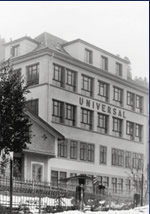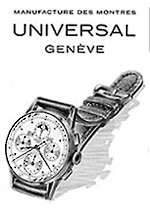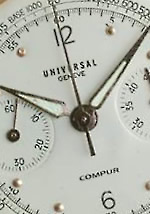 The company "Universal Watch" was founded in Locle, one of the most important watch centres in Switzerland on the 18th of January 1894.
The company "Universal Watch" was founded in Locle, one of the most important watch centres in Switzerland on the 18th of January 1894. Numa-Emile Descombes and Georges Perret, both born in Locle, registered the name "Universal Watch" for the production of cases for watches, dials, domes, movements, fitted boxes and packages for watches.
This was an extremely sensible formula since it allowed the protection of the make and promotional material.
This very same year, Numa-Emile Descombes and Georges Perret patented a 24 hour indication watch.
Unfortunately, Numa-Emile Descombes died at the age of 34.
As a consequence, on July 1897, all makes were sent to Ulysse Georges Perret and Louis-Edouard Berthoud Universal watch had the ability to foresee the huge potential of wrist-watches together with chronographs.
In 1898 high quality wrist watches not only with chronographs but also minutes recorders were launched into the market.
It was soon after that "universal watch" increased its profits from its great growth in reputation in Europe as well as the two Americas. In 1919, the company later moved to the Geneva headquarter.
It was decided to undertake some research on self-winding systems for wrist-watches
In 1925, a watch with a similar system to that of John Harwood was created. Universal created "Auto-Re", a self-winding system with an oscillating weight mechanism with spring-buffers.
Raoul, son of Georges Perret, was force to take over his father company when his father died in 1933.
In 1934 ,due to the support received from some new investors, the company changed to "Universal Watch Co Ltd. Genève".
It was during that year that the first chronograph was introduced.
It was the first chronograph wrist-watch that had two push-buttons.
The company moved to 43, Rue du Rhône, which had an entrance at the famous Grand Quai. The name "Universal" was patented.
Simultaneously, a chronograph with an additional 12 hour register was introduced as a world premiere.
A new logo had to be presented due to the registration of the brand "Universal Genève" in 1937.
Even thou there was a world wide economic depression, the models "Compur" and "Compax" were so successful that the factory in Geneva was not able to meet peoples' demands and needs.
Eventually a chronograph factory had to be opened in Pont-de-Martel in 1941. 
In 1944, the famous "Tri-Compax" model was introduced.
Sales increased incessantly all over the world. Therefore, Universal started to be a synonym for quality, good taste and reliability as well.
In 1947, as soon as the new precision automatic caliber 138 with an oscillating mass with single direction winding was introduced, Louis-Edouard Berthoud died.
The model "Polerouter", which was previously called "Polarouter", was introduced soon after the new factory in Geneva was inaugurated.
The watch was used by SAS crews during their polar flights.
In 1955 Universal Genève registered the calibre 215 "Microtor", a new model of an automatic calibre with the rotor mass incorporated in the movement.
Although it was the smallest automatic movement at that time, it was introduced in the 2nd generation of the famous "Polerouter".
The following decade it was quite noticeable the great progress in developing an introducing thinner automatic movements.
In 1966, the model "Golden Shadow" was presented.
Gerald Genta was the designer of the calibers s 66 and 67 with a thickness of 2, 5 mm.
In 1962, the first electric watches with a torsion oscillator were produced in conjunction with Movado.
In 1968, the first electronic watches were introduced, with the "Tuning Unisonic" system. They were manufactured in collaboration with Bulova.
In 1975 the thinnest analogue quartz movement in all over the world was introduced. It allowed Universal to face the "Japanese invasion" for some time.
Universal had always set its mind to combine quality and good classic taste.
The make had many admirers, from Harry Truman to Juan Peron.
It is possible to read on the dials of the new tourbillons a dedication from the artist Jean Cocteaux. It says "Les temps lui-meme regarde l'heure à la montre Universal",It was ordered form different sheiks and Arabic ministers luxurious custom made watches.
Golden watches with exquisite enamel dials are still being sought after.
Gerald Genta, one of the most famous watch designers of the twentieth century, was a contributor of the success. She designed two models which became famous all over the world: the "Polerouter" in 1954 and the "Golden Shadow" in 1966. 
Due to these two watches, Universal received the "New York Diamond Award", the "Golden Rose" in Baden-Baden, the Grand Prix of the "Ville de Genève", the "Città di Basilea" prize and the 1st price in the "Exposition Nationale Suisse" in 1964.
In 1886, after the company had been managed by the heirs of the founders, Lennard Oldman was chosen as new President of Universal Genève.
In 1988 the headquarter moved to 29, Rue de Jussy in Geneva-Thônex.
The very same year the logo changed to look they way it looks nowadays.
Due to a long crisis which struck the Swiss watch industry, the company was later taken over by the Stelux holding group in 1989
In 1993, a new production unit was open at Bienne.
The head office is now located in Geneva-Acacias after relocating for a long period of time.
Today the Universal Genève focuses on its qualities and tradition. The collection includes watches in an attractive "retro-design" , making reference to some of the greatest models of the company history.
The aim is to create new models, which derive from the famous Calibre 66, which will become the new generation of Universal Genève watches.





No comments:
Post a Comment